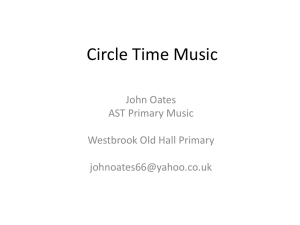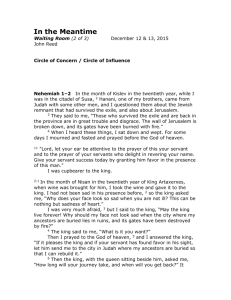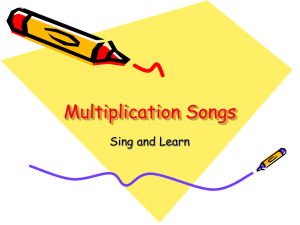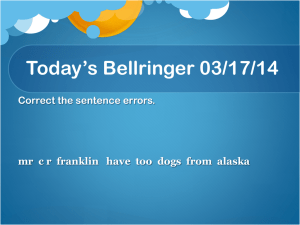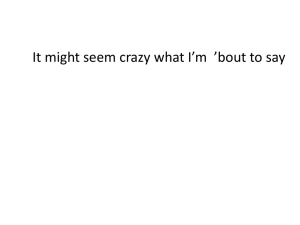commedia-games
advertisement
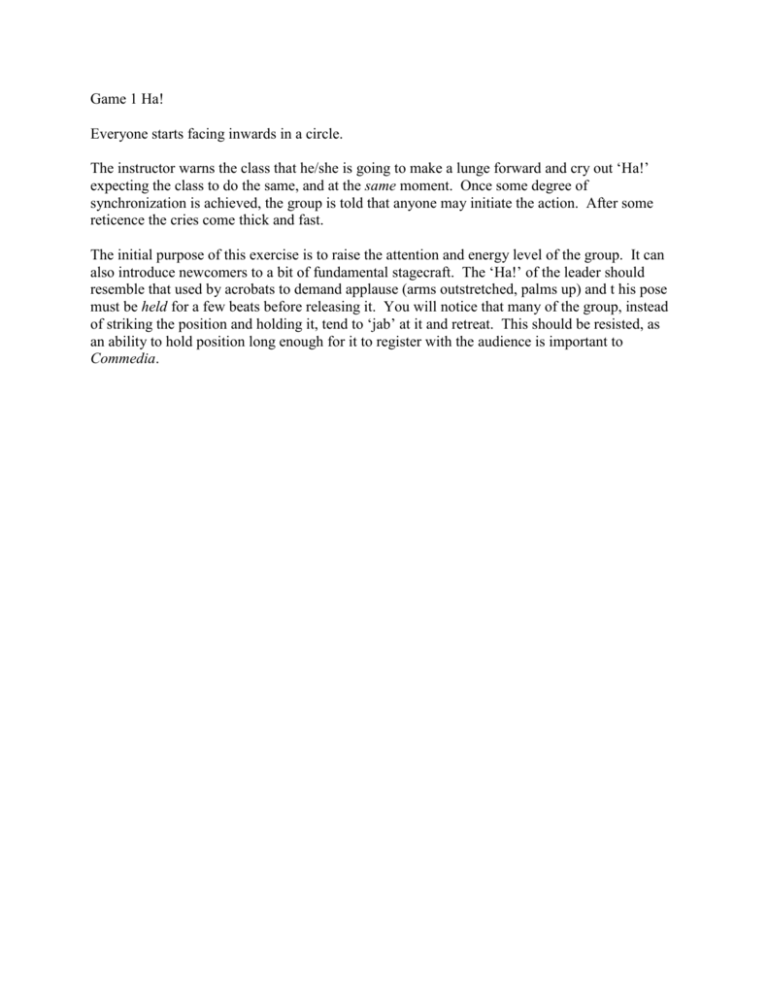
Game 1 Ha! Everyone starts facing inwards in a circle. The instructor warns the class that he/she is going to make a lunge forward and cry out ‘Ha!’ expecting the class to do the same, and at the same moment. Once some degree of synchronization is achieved, the group is told that anyone may initiate the action. After some reticence the cries come thick and fast. The initial purpose of this exercise is to raise the attention and energy level of the group. It can also introduce newcomers to a bit of fundamental stagecraft. The ‘Ha!’ of the leader should resemble that used by acrobats to demand applause (arms outstretched, palms up) and t his pose must be held for a few beats before releasing it. You will notice that many of the group, instead of striking the position and holding it, tend to ‘jab’ at it and retreat. This should be resisted, as an ability to hold position long enough for it to register with the audience is important to Commedia. Game 2 Silly Noises The leader asks for one student to step into the circle and make a silly sound and accompanying gesture that the rest of the class must copy. Each student should do this, coming forward of their own volition. The aims here are that the duplication should be as exact as possible and fellow the original (two important aspects of later improvisation). This game should help the players feel free to invent and not be inhibited in doing something foolish before their collegues. Game 3 Silly Walks One person crosses the circle doing an eccentric or comic movement, again accompanied by vocalization. He/she then takes the place occupied by another person in the circle who immediately moves off with their own invention, until all have had a turn. This game should help the players feel free to invent and not be inhibited in doing something foolish before their colleagues. Longer term aims are (1) using vocal sound and movements simultaneously (2) inventing instantly – as each takes over, no time must be allowed for ‘thinking’ (3) using rhythm in the crossing; that is, repetition of movement and sound: e.g., a hen clucking and flapping wings, etc. Game 4 Glee! Everyone begins raising their shoulders and tensing all muscles as much as possible, screwing up their faces and saying the world ‘glee’ in a very tense and restricted tone. This is held for a few moments and then, on the instructor’s command, ‘Deadpan’, all relax the body and assume a ‘deadpan’ expression. When the class is comfortable with this, they are asked to pint at each other (still retaining the tension) s they say ‘glee’. The pointing should be as inventive as possible, such as over the shoulder, between the legs, etc. When in ‘relaxed mode’ they should be able to look at each other without losing the ‘deadpan’ in laughter. The purpose here is to encourage the use of unusual body positions; to practice tension and relaxation and to be able to confront without laughter. Game 5 Make Yourself Laugh Take a big breath and then, with a sigh, exhale every bit of air from the lungs. When you think you’ve done that, raise the shoulders and with a ‘Ha!” exhale some more. Then bounce the shoulders and shake the body, with ‘Ha! Ha! Ha! Ha!’ still without taking a breath. Time now for a big breath and a repeat of the sequence, a little quicker, this time varying the pitch of the ‘Ha’s’, high and low. If everyone does this together, the infectious nature of laughter ensures that the room shakes with genuine laughter. Game 6a Harlequin Knees Bend Stand with the feet fairly apart and turned out (ballet 2nd position). Take approx 2 seconds for each count. Count 1. Count 2. Count 3. Count 4. Bend the knees slightly (ballet demi plié). Increase the bend. Increase the bend even more (ballet grande plié). Straighten the knees, back to original position. On the first of the bends assume an expression of irritation or annoyance, which increases on each bend. Go to ‘deadpan’ on the rise. Repeat several times. This introduces the concept of movement associated with a particular character. The pliés are also a necessary part of any physical warm-up. Game 6b Harlequin Surprised Stand with the feet apart and turned out. Arms by the sides. Count 1. Raise the shoulders. Mime: ‘sudden surprise’ (jaw drops). Count 2. Sudden drop into full knees bend (‘I don’t believe it’). Count 3. Sharply drop shoulders (mildly aggressive). Count 4. Slowly straighten knees, and at the same time ‘wobble’ the head from side to side (look of nonchalance: ‘See if I care!”). Game 6c Harlequin Hears No Good of Himself Stand with feet a little wider apart than in Game 6b: arms by sides. Count 1. Count 2. Count 3. Count 4. Raise right shoulder only. Lunge the right leg to the right, head and body facing front (but advancing the right ear as if listening). Drop right shoulder suddenly (‘Fancy saying that!’). Slowly return to upright position (mumble, mumble). Repeat to the left. Game 7 Smart Walking Starting with walk foot, walk briskly round in a circle. While walking, count aloud in ‘eights’. This number is used because of its musical affinity, and the following is helpful method of counting, often used by dancers: 1/ 2, 3, 4, 5, 6, 7, 8. 3/ 2, 3, 4, 5, 6, 7, 8. 5/ 2, 3, 4, 5, 6, 7, 8. 7/ 2, 3, 4, 5, 6, 7, 8. 2/ 2, 3, 4, 5, 6, 7, 8. 4/ 2, 3, 4, 5, 6, 7, 8. 6/ 2, 3, 4, 5, 6, 7, 8. 8/ 2, 3, 4, 5, 6, 7, 8. Then start again with: 1/ 2, 3, 4, 5, 6, 7, 8. etc. When all find this easy to do, begin counting silently. Making it more complicated, take 8 walks forward, and then make half a turn (turn a half circle around towards the left shoulder – counterclockwise) and walk 8 steps backward, still continuing in the same direction. Then, turning toward right shoulder (clockwise), step forward and continue, but reducing the number of forward steps to 4, turn and make 4 steps backward. Repeat the 4 forward and 4 backward (to complete the fourth count of eight). Repeat the whole secquence from the first 8 walks forward. This game is good for getting people to move together as a team, develop a rhythmic snese, and to introduce ‘Numerical Reduction’ (see later). Game 8 Walking and Clapping Walk in a circle as before and again continue to silently count in ‘eights’. After establishing a rhythm, everyone claps hands on the first of the 8 steps. On the second count of 8, clap hands on the second step. On the third count of 8, clap on the third step, and so on until the clap comes on the 8. After that, start again on the first beat: CLAP/ 2, 3, 4, 5, 6, 7, 8. 3/ 2, CLAP, 4, 5, 6, 7, 8. 5/ 2, 3, 4, CLAP, 6, 7, 8. 7/ 2, 3, 4, 5, 6, CLAP, 8. 2/ CLAP, 3, 4, 5, 6, 7, 8. 4/ 2, 3, CLAP, 5, 6, 7, 8. 6/ 2, 3, 4, 5, CLAP, 7, 8. 8/ 2, 3, 4, 5, 6, 7, CLAP. Start again: CLAP/ 2, 3, 4, 5, 6, 7, 8. etc. Game 9a Put on a Happy Face Inward-facing circle. The right hand, fingers together, thumb proud, palm inwards is passed slowly over the face upwards from below the chin to just above the forehead, and as it passes a broad exaggerated smile is brought to the face. The player ahs put on a ‘happy’ face and until he/she removes it the facial expression remains fixed like a mask. All movements, sounds, words will be joyful. She/he then wipes it off with a downward hand movement, from above the forehead to below the chin, culminating in a ‘sad’ face: corners of the mouth down etc. He now fixes a ‘sad’ face and behaves ‘miserably’. Changes from one to the other may be slow or rapid. Practice it also with the left hand. Game 9b Happy Face Duo Work in pairs. Players may alter their own or their partner’s expression, by reaching out and ‘wiping’ the others’ face into ‘happy’ or ‘sad’. In the ‘happy’ or ‘sad’ fixed face we have the first approach to the nature of a mask, and the making of the body movements, sounds or words fit the assumed ‘mask’. It is a valuable introduction to the mastering of the facemask technique. Game 10a Oppo and Appo A game to develop physical dexterity prior to Commedia challenges. Form an inward facing circle. The footwork is simple enough, and should be done in a gentle and relaxed style. Count 1. Step on the right foot (on place, i.e. on the spot). Count 2. Low kick with the left foot. Count 3. Step on the left foot (on place). Count 4. Low kick with the right foot. Repeat ad lib. The whole movement remains on place without traveling. Version (a) As you do the swing the arms are in opposition – that is: Right arm forward as you kick the left foot. Left arm forward as you kick the right foot. Do this until everyone finds it really easy. Version (b) Start again, but now swing the arms in apposition – that is: Left arm forward as you kick the left foot. Right arm forward as you kick the right foot. Do this until everyone finds it really easy. Version (c) – the tricky one! While keeping the alternating step/kicks going, perform four with the arms in opposition and four with the arms in apposition. Repeat ad lib. It helps to give verbal command for the arms: ‘Right, left, right, left – left, right, left, right – right, left, right, left – left,’ etc. Repeat ad lib. Game 10b Oppo and Appo Duet Work in pairs. Use the step/kicks from Game 10a to travel in a diagonal line across the practice space. All three versions (a) Opposition, (b) Apposition and (c) Mixed can be tried, and once the mechanics are mastered, characterization can be added with: (1) Mime: one partner is in a hurry to get somewhere and is being delayed by the other for example, or (2) Dialogue: while keeping the step going, improvise a spoken conversation on any given subject: say ‘money’, ‘food’, or even the weather! (Choose a ‘modern’ subject before attempting anything on a Commedia dell’Arte theme.) The purpose here is to provide a preliminary exercise in using movement and speech together. Movement on the whole needs to be ‘on the automatic’, so that the conscious mind can concentrate on the dialogue improvisation. Game 11a The Sad to Happy Scale Stand in an inward-facing circle. Make the most miserable facial and body expression possible; then the most outrageously happy that can be done. Given a steady eight counts, starting with ‘extremely sad’, progress in sharp stages up to ‘extraordinarily happy’. Then, given counts downward, drop in stages back to ‘extremely sad’. Example: allow about 5 seconds for each ‘emotion’. 1. 3. 5. 7. Abject misery! Pity me! Things are not so bad. Very good! Or something similar. 2. 4. 5. 8. Exceedingly sad. A ray of hope. No, they’re good. Ecstasy! Game 11b Jumping the Scale Once the steps of the emotions scale are clearly in mind, the leader calls out random numbers (1 to 8) and the class assumes the appropriate emotion signified by the number. Note 1: These are games! The emotions employed are applied externally, and are intended to extend the performer’s range and flexibility. It does not mean that in performance, when there is a script or scenario, the actor doesn’t need to fully motivate his every move and emotion. Note 2 (in references to Game 10b): The timing relationship between movement and word is complicated and in performance has to be judged exactly, but in initial practice, concentrate on trying to do them both at the same time. Practice Drill: Hand Movements a) Raise the right forearm to a comfortable position and rotate the right hand from the wrist: 8 times in the clockwise direction: short pause, then: 8 times in the counterclockwise direction. b) Repeat with the left hand: 8 times in the counterclockwise direction: pause, then: 8 times in the clockwise direction. c) Now work with both hands at the same time: Right hand revolves clockwise, left hand counterclockwise – which may be said to be ‘outward’. Then, right hand counterclockwise, left hand clockwise – which may be said to be ‘inward’. This can help to understand something of the language of movement. If you take the ‘outward’ rotations at not more than a second per revolve, with the merest pause at the high point, it will be easily demonstrated that, independent of any facial expression, the signal given is a positive one (happy, pleasant, welcoming) while the ‘inward’, with slight pause on the lowest part of the circle, will give a negative signal (unhappy, rejective, dismissive).
